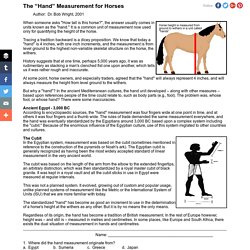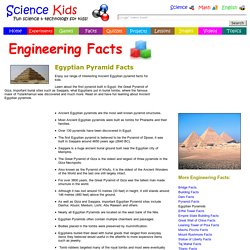

History - Ancient History in depth: Pyramid Challenge. Menu. Pi, Where does it come from? The Hand Measurement for Horses. Author: Dr.

Bob Wright, 2001 When someone asks "How tall is this horse? ", the answer usually comes in units known as the "hand. " It is a common unit of measurement now used only for quantifying the height of the horse. Tracing a tradition backward is a dicey proposition. History suggests that at one time, perhaps 5,000 years ago, it was as rudimentary as stacking a man's clenched fist one upon another, which tells us it was rather rough and inaccurate. At some point, horse owners, and especially traders, agreed that the "hand" will always represent 4 inches, and will always measure the height from level ground to the withers. But why a "hand"? Ancient Egypt - 3,000 BC According to encyclopaedic sources, the "hand" measurement was four fingers wide at one point in time, and at others it was four fingers and a thumb wide.
Survey and the alignment of the Khufu pyramid - ancient Egyptian techniques. List25. Great Pyramid of Giza Research Association. The Great Pyramid of Giza stands on the northern edge of the Giza Plateau, located about 10 miles west of Cairo.

It is composed of over 2 ½ million blocks of limestone, which weigh from 2 to 70 tons each. It's base covers over 13 acres and its volume is around 90,000,000 cubic feet. You could build 30 Empire State buildings with its masonry. It is 454 feet high which is equivalent to a modern 48-story building. There are currently 203 courses or steps to its summit. From an old post card around 1910 For more general information go to GENERAL INFORMATION - PART 1. Building the Great Pyramid Year 1: Six Letters from Hemienu. If the journey of a thousand miles begins with a single step, what were the first steps Hemienu took when starting the construction of the Great Pyramid?

Six letters from Hemienu is a work of epistolary historical fiction, with a very heavy emphasis on historical, which explores the sort of details that would have required his attention immediately after choosing a building site for Khufu’s Pyramid. The purpose of these imaginary missives from the desk of the Overseer of All the King’s Works is to give the reader an idea of the amount of planning, materials, and manpower involved not only in building the Great Pyramid, but in preparation for the work itself. There were mines and quarries to be opened, a fully functional workers’ city to be constructed, and an entire nation to be mobilized. Step Pyramid of Djoser, Saqqara. Intended to hold his mummified body, Pharaoh Djoser's Step Pyramid at Saqqara began as a traditional, flat-roofed mastaba.

But by the end of his 19-year reign, in 2611 B.C., it had risen to six stepped layers and stood 204 feet (62 meters) high. It was the largest building of its time. Extensive use of stone—here and there carved to resemble wood, reeds, or other softer materials—made the tomb more durable than its mud-brick forebears. Such pioneering techniques led many ancient historians to credit the chief architect, Imhotep, with inventing stone architecture. The Step Pyramid complex was enclosed by a 30-foot (10-meter) wall and included courtyards, temples, and chapels covering nearly 40 acres (16 hectares)—the size of a large town in the third millennium B.C.
As in earlier mastaba tombs, the Step Pyramid's burial chambers are underground, hidden in a maze of tunnels, probably to discourage grave robbers. NEXT: Steps Ahead >> << Return to Pyramid Index. History - Ancient History in depth: Development of Pyramids Gallery. Ancient Egyptian Pyramid Facts for Kids - Giza, Djoser, Saqqara, Tutankhamun. Ancient Egyptian pyramids are the most well known pyramid structures.

Most Ancient Egyptian pyramids were built as tombs for Pharaohs and their families. Over 130 pyramids have been discovered in Egypt. History - Ancient History in depth: Development of Pyramids Gallery. Thermal Scan of Egypt’s Pyramids Reveals Mysterious Hot Spots - History in the Headlines. Print Cite Article Details:Thermal Scan of Egypt’s Pyramids Reveals Mysterious Hot Spots Author Sarah Pruitt Website Name History.com Year Published 2015 Title Thermal Scan of Egypt’s Pyramids Reveals Mysterious Hot Spots URL Access Date December 14, 2015 Publisher A+E Networks Built more than 4,500 years ago, during Egypt’s 4th Dynasty of pharaohs, the pyramids at Giza are some of the most celebrated manmade monuments in history.

Yet no one really knows how these magnificent ancient structures were built, on such a massive scale, in a relatively short period of time. The recently launched Operation Scan the Pyramids project aims to probe this enduring mystery by using high-tech but non-invasive methods to examine the pyramids. In recent months, experts have been searching for hidden chambers located within the Egyptian pyramids, as well as for additional insight into how these amazing structures could have been built.
Building the Pyramids Video - Ancient Egypt. The Great Sphinx Video - Ancient Egypt. Uncovering Secrets of the Sphinx- page 3. This past fall, at the behest of “Nova” documentary makers, Lehner and Rick Brown, a professor of sculpture at the Massachusetts College of Art, attempted to learn more about construction of the Sphinx by sculpting a scaled-down version of its missing nose from a limestone block, using replicas of ancient tools found on the Giza plateau and depicted in tomb paintings.

Forty-five centuries ago, the Egyptians lacked iron or bronze tools. They mainly used stone hammers, along with copper chisels for detailed finished work. Bashing away in the yard of Brown’s studio near Boston, Brown, assisted by art students, found that the copper chisels became blunt after only a few blows before they had to be resharpened in a forge that Brown constructed out of a charcoal furnace. Lehner and Brown estimate one laborer might carve a cubic foot of stone in a week. At that rate, they say, it would take 100 people three years to complete the Sphinx. Lehner spotted something perhaps even more remarkable. Egyptian Pyramids - Ancient History. No pyramids are more celebrated than the Great Pyramids of Giza, located on a plateau on the west bank of the Nile River, on the outskirts of modern-day Cairo.

The oldest and largest of the three pyramids at Giza, known as the Great Pyramid, is the only surviving structure out of the famed seven wonders of the ancient world. It was built for Khufu (Cheops, in Greek), Sneferu’s successor and the second of the eight kings of the fourth dynasty. Though Khufu reigned for 23 years (2589-2566 B.C.), relatively little is known of his reign beyond the grandeur of his pyramid. The sides of the pyramid’s base average 755.75 feet (230 meters), and its original height was 481.4 feet (147 meters), making it the largest pyramid in the world.
Three small pyramids built for Khufu’s queens are lined up next to the Great Pyramid, and a tomb was found nearby containing the empty sarcophagus of his mother, Queen Hetepheres. The middle pyramid at Giza was built for Khufu’s son Khafre (2558-2532 B.C). You Wouldn't Want to Be a Pyramid Builder!: A Hazardous Job You'd Rather Not ... - Jacqueline Morley. History - Ancient History in depth: Building the Great Pyramid.